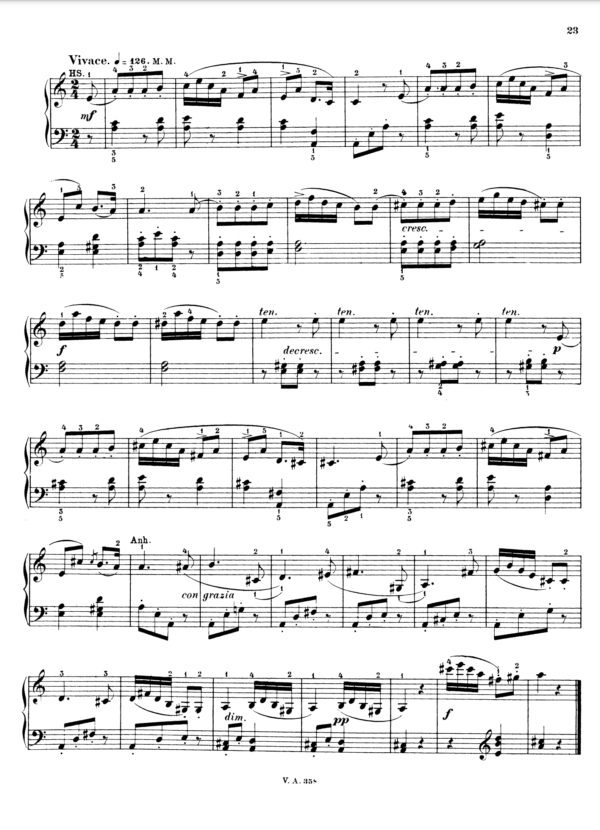Moderate
A list

Clementi ~ Vivace (A2) is likely to become rather boring if it is not played at a reasonably brisk one-in-a-bar pace. A good starting point is probably the left hand; playing the outline as three-note chords, lightly, and in the correct order will help the student to understand the harmonic flow, which is simple enough. Assuming a comfortable knowledge of scales, the right hand lines should not prove difficult and, in this piece, it is better to get to know the parts with hands separately at speed, rather than the starting point being slowly hands together.
Hedges ~ Hornpipe Rondo (A4) (duet). Rondos are good to learn for the obvious reason that the theme is repeated later in the piece! The tempo here is brisk. The primo part plays often in unison and there is plenty of imitation and interplay between the primo and secondo parts, making this a good piece to engage in the kind of chamber music playing that pianists can enjoy with their teacher, or practise with a parent who might play.
Neugasimov ~ Moody Gigue (A6) - a brief, quirky Gigue. The constant change from minor to major provides the main feature of compositional interest and would be an interesting starting point from a structural standpoint. Anthony Williams (ABRSM Grade 3 recording) shows how those changes can be clearly defined and phrased in a musical way, with interesting use of varied articulation between the hands.
Reinecke ~ Vivace (A8) is a delightful piece, requiring some nimbleness of finger work, first in the minor, then the major key.

Weber ~ Scherzo (A10) is a short ternary form piece with left hand detached chords accompanying right hand semiquavers. Its middle, major key section has legato right hand chords with slurred left hand quavers, followed by some more extended scale passages.
Schumann ~ Wilder Reiter (A13). A popular previous syllabus piece, the tempo needs to be lively and the playing crisp and well coordinated. It is always better if the accompanying hand (sometimes left, sometimes right) can ease off the dynamic level so that the performance does not become leaden and simply loud throughout.
_____________________________
B list

Nancy Litten ~The Sad Ghost (B1) is a slow and gently unfolding piece. Even its climax point forte should not sound agitated or over-phrased, merely significantly present as the shadow of this ghost gradually disappears back from whence it came. The final 6 bars need to be judged carefully, so as to have something in reserve and not reach the pp of the penultimate bar too soon. It could well be worth writing out the opening bars 1-2 & 4-5 in 3/4 time signature, where the timing will seem a little more obvious than it does in 6/8.
pianist ~ Peter Noke
Yoshinao Nakada ~ The Song of Twilight (B3) is one of those peaceful pieces that should almost play itself once the notes have been learned. However, it's not quite like that in reality due to the need to achieve a quiet and consistently even, sustained left hand flow of chords. This does require some use of pedal. Best to aim for a consistent method of pedalling that works pretty much throughout.
The following suggestion can work well, but be certain to get it going with just the left hand first: pedal goes down halfway through the first beat/pedal lifts exactly on the third beat and depresses again halfway through the third beat. Repeat throughout, with the exception of the changing harmonies in bars 8, 10a, 11, 12 & the final bar. Remember to do the repeat.
pianist ~ Peter Noke
Walter Carroll ~ Spraymist (B7) is a charming piece that paints a picture of the gentle spray as it hits the bow of the boat on the open sea. It is atmospheric and requires good use of pedal and an imaginative musical approach if it is to release all its expressive secrets to the performer.
Good use of rubato is also important in Gurlitt ~ Song (B8). Pieces such as this can become gems in the right hands but rather less appealing when the playing is simply literal, and even metronomic. Here are the last paragraphs of ABRSM's sensitive version, played here by Anthony Williams:
Trad. Irish ~ She Moved Through the Fair (B10) - to capture the mysterious mood of this traditional and well-known Irish tune is to evoke the spirit of Irish folklore. There is a compelling beauty and a concealed angst as some of the stranger harmonies envelop the tune. It is certainly a piece for the more enquiring and sophisticated musical mind, else its secret will remain elusive.
This wonderful arrangement from the King's Singers may perhaps help to unlock the poetry inside:
Janet and Alan Bullard ~ Thames Sunrise (B11) like a watercolour, paints a fluid scene of changing light as the sun rises over the scene. It's all about sensitivity to the subtly changing harmonies, taking time for these to register, and not being in a hurry so that you can fully enjoy the lovely jazz-influenced colours at the end.
Mendelssohn ~ Romance (B12) is a gently expressive piece with interesting contrapuntal two-part textures.
Tchaikovsky ~ Chanson Italienne (B13) is a charming piece with its perpetual left hand staccato accompaniment to the coy, sometimes enticing twisting of the right hand legato, lyrical lines. Poise in the phrasing, with careful use of rubato, is a must if the performance is to dance and sing, invigorating the imagination.
_____________________________
C list

William Gillock ~ The Spanish Guitar (C2) evokes the vibrant mood of the Flamenco, its driving rhythmic flourishes thrusting you forward to join in. There is contrast, too, in the rather haunting and much quieter middle section before being pitched suddenly back into the heat of the dance.
Scott Joplin ~ The Entertainer (B3). This adapted version of the original gives a great opportunity to play one of the best-known of Joplin's rags. Whilst you'll sometimes hear this played very fast, this is not the best way. A solid beat is an essential grounding for a successful performance, so plenty of left hand practice and secure memorization are desirable.
Ostensibly a recording of Joplin himself playing this can be found here. It carries the warning that it is not necessary to play it this fast, even though it is exciting to hear this version:
Agay ~ Little Rhapsody on Hungarian Themes (C4) (duet) is a lively piece with its exciting accelerando at the end. The primo part contains the melodies in octave unison parts and at a sixth apart, as well as more accompanimental roles and a range of chordal playing. A great piece for musical excitement and for developing aural awareness and ensemble playing.
M.Bober & G.Goransen ~ Rushing River (B5) will appeal to those who enjoy this easy-going style. It is similar in style to the music of Einaudi, though less repetitive in its use of themes.
Mike Cornick ~ The Waltz of the Elephants (B6) is a tongue-in-cheek homage to our wonderful large friends of the jungle! Make no mistake, they can be seen showing a certain curiosity towards the piano!
Mark Goddard ~ Locked on Latin (B7) is a snappy, cool piece with which to have fun! It lies well under the fingers, the main motif being shared between the hands of the primo part, and has a variety of similar motion playing without being rhythmically complex.
Elton John & Tim Rice ~ Can You Feel the Love Tonight? (C8) A popular choice for fans of The Lion King, no doubt. It is easy for it to sound somewhat brash and with all the same kind of tone throughout. As long as it is rhythmic, then that will work although, to get a more sophisticated effect, aim to bring out the melodic lines and keep the repeated and underneath chords at a more subdued level.
Mancini & Mercer ~ Moon River (C9) could well appeal more to an older age group, and this arrangement works well in putting it within their grasp. Much depends on the fluency of the left hand to keep the lines moving and sounding confidently phrased.
Valerie Capers ~ Ella Scats the Little Lamb (C11) is easy in some senses (for example, the steady left hand groove), although it can be harder to achieve a natural jazz feel and a convincing grasp of some of the syncopation.
Hoffman ~ Waldvöglein (B13) - a gentle reflective piece where the use of pedal will certainly enhance otherwise rather dry textures. Making sufficient tonal and dynamic difference between the right hand melodic lines and the left hand accompaniment will certainly lift the quality of the performance.
_____________________________
Other content in “Grade 3”
-
Current: Moderate
